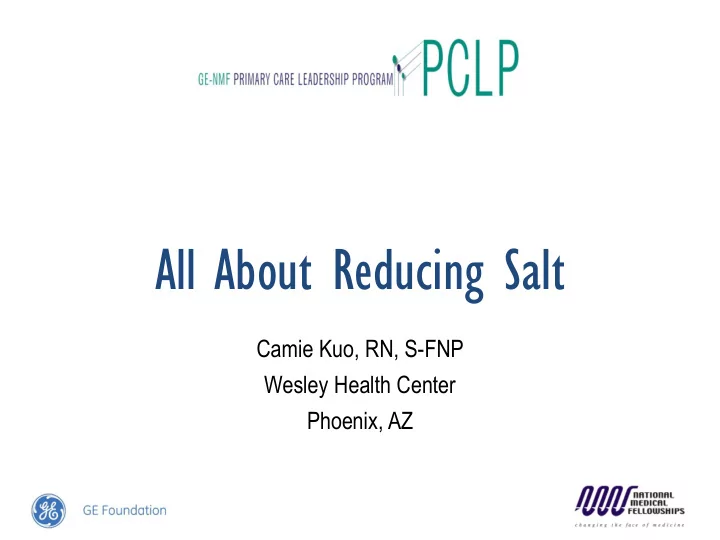

All About Reducing Salt Camie Kuo, RN, S-FNP Wesley Health Center Phoenix, AZ
Introduction & Background • US Food & Drug Administration 1 recommends: • <2300mg of daily sodium consumption (general population) • <1500mg (at risk) • A 2012 study 2 shows: • 99.4% of US adults consume >1500mg sodium • Most research focus on dietary salt intake & health consequences (i.e., blood pressure, cardiovascular-related deaths) 3, 4 • Fewer studies address patients ’ attitudes and barriers 5,6 • Healthy People 2020 7 • Decrease number of adults with hypertension (HTN); target 26.9% • Estimated 29.9% US adults had HTN in years 2005-2008 • There is a need to assess patients’ beliefs, knowledge, and barriers with respect to following a low-salt diet
Methodology • Questionnaire packet administered to patients attending either Diabetes or HTN class over 2-week period • 7/28 – 8/8/14, 4 sessions total • Questionnaire packet available in English & Spanish: • Cover sheet with instructions • Demographic Questionnaire (age, gender, race & ethnicity) • Dietary Sodium Restriction Questionnaire (DSRQ) 8 • 4 Parts consisting of questions using a rating scale • Part 1 (Q1-11): General Information • Part 2 (Q12-23): Perceived Behavioral Control Subscale • Part 3 (Q24-27): Subjective Norm Subscale • Part 4 (Q28-34): Attitudes Subscale • Translated into Spanish & back-translated
Results • Participants • Total 20 participants (13 F, 7 M) • 23 Questionnaires distributed, 3 declined (response rate 87%) • 100% Latino/Hispanic & majority in 51-60 age group • Part 1 (Q1-11) • 40% (N=8) reported they were prescribed a low salt diet by a health care provider • 50% (N=10) reported that they try to follow a low salt diet • Note that these two groups overlapped (N=5)
Results: Part 2 • Part 2: Perceived Behavioral Subscale (Q12-23) • Indicate below, how much the following items keep you from following a low salt diet [from 1-5 (1= not at all; 5 = a lot)] • Examples: Cost of low-salt foods, time to prepare foods, etc. • Average ratings shown below 5.0 4.0 3.0 2.0 1.0 Q 12 Q 13 Q 14 Q 15 Q 16 Q 17 Q 18 Q 19 Q 20 Q 21 Q 22 Q 23
Results: Parts 3 & 4 • Part 3: Subjective Norm • Part 4: Attitudes Subscale Subscale (Q24-27) (Q28-34) • Rate from 1-5 (1 = not at • Rate from 1-5 (1 = not at all; 5 = a lot) to statements all; 5 = a lot) to statements (e.g., My doctor thinks I (e.g., It is important for me should follow a low-salt to follow my low-salt diet ) diet) 6.0 6.0 5.0 5.0 4.0 4.0 3.0 3.0 2.0 2.0 1.0 1.0 Q 24 Q 25 Q 26 Q 27 Q 28Q 29Q 30Q 31Q 32Q 33Q 34
Discussion & Conclusion • At least 50% try to follow a low- salt diet w/o MD’s order • No universal barrier to eating a low-salt diet • Average ratings more consistent throughout Parts 3 & 4 • Most acknowledge relationship between low-salt diet and health • Most acknowledge importance of low-salt diet • Limitations • Small sample (N=20) • Incomplete responses & response bias possible • Literacy not assessed due to limited time • DSRQ originally developed for patients with heart failure and were predominately white
Recommendations • Need for individualized plans • Address both cultural and financial barriers • For future data collection • Obtain larger sample • Assess literacy prior to questionnaire distribution • Assess motivational level • Provide one-on-one guidance & offer more time
References 1. U.S. Food and Drug Administration (FDA). (2010). Lowering salt in your diet. Retrieved July 11, 2014 from http://www.fda.gov/forconsumers/consumerupdates/ ucm181577.htm 2. Cogswell, M.E., Zhang, Z., Carriquiry, A.L., Gunn, J.P., Kuklina, E.V., Saydah, S.H., … Moshfegh, A.J. (2012). Sodium and potassium intakes among U.S. adults: NHANES 2003-2008. American Journal of Clinical Nutrition, 96, 647-657. doi: 10.3945/ajcn.112.034413 3. Ha, S.K. (2014). Dietary salt intake and hypertension. Electrolyte Blood Press, 12, 7-18. doi: 10.5049/EBP.2014.12.1.7 4. Bartlett, H.L., Smith, D.G., & Ebrahim S. (2004). Advice to reduce dietary salt for prevention of cardiovascular disease. Cochrane Database of Systematic Reviews 2004, Issue 1. Art. No.: CD003656. doi: 10.1002/14651858.CD003656.pub2 5. Horowitz, C.R., Tuzzio, L., Rojas, M., Monteith, S.A., & Sisk, J. (2004). How do urban African Americans and Latinos view the influence of diet on hypertension? Journal of Health Care for the Poor and Underserved, 15, 631-644. 6. Van der Wal, M.H.L., Jaarsma, T., Moser, D.K., van Gilst, W.H., & van Veldhuisen, D.J. (2007). Unraveling the mechanisms for heart failure patients’ beliefs about compliance. Heart & Lung, 36, 253-261. 7. U.S. Department of Health and Human Services. (2014). Heart disease and stroke. Retrieved August 11, 2014 from http://healthypeople.gov/2020/topicsobjectives2020/objectiveslist.aspx?topicId=21 8. Bentley, B., Lennie, T.A., Biddle, M., Chung, M.L., & Moser, D.K. (2009). Demonstration of psychometric soundness of the Dietary Sodium Restriction Questionnaire in patients with heart failure. Heart & Lung, 38 , 121-128. doi:10.1016/j.hrtlng.2008.05.006
Acknowledgments • Kathleen Brite, MD • Katherine Kenny, RN, DNP, ANP • Ana Guzman • Dynorah Harries • Nelson Pacheco • Fran Aragon, LCSW • Emma Viera, PhD • All the wonderful staff at Wesley Health Center
Recommend
More recommend